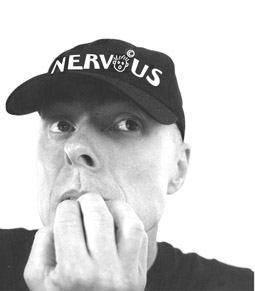Treading on critic's toes
Josephine Wilson: Lavers & Burrt, Nervous

John Burrt, Nervous
photo Katie Lavers
John Burrt, Nervous
We have entered the era of Innovation. In this era, the language of hybridity is increasingly lassoed into creative couplings that are expected to yield unforeseen benefits in the areas of technology and the arts. ‘Art and science’ are the buzzwords of the moment. ‘Risk’ sits on the positive side of this equation, and anyone who dares stand still risks falling right over. Yet in the forgotten trenches where small companies and creative individuals fight it out, risk is an increasingly impossible word. Who can afford to take risks in this climate?
John Burtt takes risks with Nervous, his recent 1 hour solo performance at PICA. John is well known for his collaborations with Skadada, but this time he steps on stage without the accoutrements that have become de rigeur in contemporary performance. No pulsing sound, no montage of groovy Troy Innocent images, no elaborate set—just a performer, a microphone and something to say. This is certainly not dance as we know it. Nervous is, however, the most physical of performances. Conflicting impulses converge and erupt as the body becomes an occupied site. The premise is quite simple, perhaps not wholly original. The performer has ingested a Hypermart, a kind of giant shopping/entertainment/conference centre, a hybrid human-machine complete with a security control centre and rogue elevator. The tone is satirical, the pace breakneck, and the performer’s task Herculean. It is not easy to simulate a car chase with one body and a fast-moving tongue.
Nervous is aptly titled. The experience of watching Burtt perform is like seeing a newcomer to the tightrope-walking business attempt to cross Niagara Falls. Can the performer pull it off, keep on track, hold the audience? When he reached safety I applauded heartily, along with the rest of the enthusiastic audience.
There are weaknesses. The script is not always funny. The writing is uneven, and the performance occasionally falters, particularly where Burtt resorts to a Some Mothers Do ‘Ave ‘Em campiness. Nervous would benefit greatly from a script-editor and a dramaturg. Despite all this, Nervous remains funny, brave and worthy of attention. Which is why the reception in both the local WA paper and The Australian is cause for comment. I can only conclude that both reviewers fail in that most unquantifiable of graces—generosity. For them the risk implicit in Nervous meant nothing. They didn’t care if John Burtt fell.
“Tedious”, “juvenile”, “silly”, “irrelevant”, wrote Naomi Millet in The West Australian. And, “…his skill is largely wasted in Nervous, because movement has been pared to a minimum.” “Worst of all”, writes Rita Clarke in an equally dismissive review in the Oz, “he doesn’t dance, staying permanently rooted on the spot.” Burtt has committed the fatal mistake of opening his mouth and refusing to move (I am taken with the image of the reviewer as organ-grinder, the performer as monkey. That damned monkey just won’t dance!). But Skadada has always sought to extend itself beyond dance. Text, voiceovers and narration have been integral to its process.
It is the idea of the dancer as actor/comedian that most offends the reviewers. “The problem is,” writes Clarke, “John Burtt has reinvented himself as a comedian. Bad move.” But Burtt has always been in his metier with comedy. Nervous is a shift in the artist’s focus, but it is not without precedent or preparation. There are specific skills that must be learnt by the actor who speaks, and the performer undertook training in these areas in preparation for Nervous. As a dancer, Burtt has long drawn on the potential of the body as a site of comedic catastrophe and local angst. The subtext of Clarke’s review is that dance is somehow unmediated, silent, that it does not dissemble.
Reviews matter greatly, particularly if you live in the far distant West. A bad review can kill a local audience and influence the future national reception of an your work. Speaking for West Australian work, it is apparent that local reviewing remains a mystifying and opaque business.
Artists are faced with a contradiction. On the one hand, the rhetoric of risk suggests that innovation will be its own reward. On the other hand, extending our areas of established practice places an unavoidable question mark over the final outcome of a work. Do we sacrifice certitude for experimentation and open-ended play?
The situation is certainly enough to make us all very nervous.
Nervous, director Katie Lavers, performer John Burrt, Perth Institute of Contemporary Art, July 26-August 4
RealTime issue #45 Oct-Nov 2001 pg. 12






